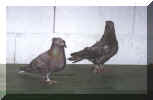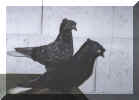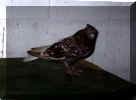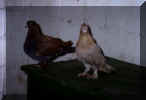



The
Iranian Highflyer
Have
you ever seen a photo of a pigeon in a magazine and hope that someday you'd have
the chance to see it in person? When 1 first saw a photo of the "Iranian
Roller" accompanying an article in an old American Pigeon Journal (Dec.
1983), 1 was fascinated by the description of this flying breed from the Middle
East. It was said to have a wingspread of up to 30", yet the body was not
much bigger than that of the Birmingham Roller. Wow! Talk about being meant to
fly! The author actually stated that the term roller was inappropriate in that
is was "an endurance flyer that took a completely different evolutionary
path than our flying Tippler ... with a wing and skeletal structure more
resembling a buteo (hawk) than a pigeon". In other words, it was meant to
soar. Being a fancier who enjoys flying pigeons, the description of this breed
fascinated me. If 1 could only find some, 1 knew I'd enjoy them. As with the
case of rare breeds, they are (of course) hard to find. 1 didn't know anyone who
had ever seen these birds in person, much less see them fly. My only encounter,
it seemed, would be what 1 had read in the article in that old magazine.
One
of the fortunes of belonging to an all breeds pigeon club, like the San Diego
Metro Pigeon Club, is that 1 have the opportunity to meet other pigeon fanciers
who own breeds of pigeons different from what 1 raise. 1 may not be able to
personally raise them all, but 1 can still enjoy the many varieties our members
raise and show. A little more than one year ago, a fancier joined our club whose
native country is Iran. His name is Amir. Discovering that 1 enjoy flying
breeds, Amir began to describe a pigeon from his native country that was a great
flyer
and could soar in the sky for hours.
He called it an Iranian Highflier. 1 couldn't believe what 1 was hearing!
1 asked him more questions, and soon realized that he was speaking of the same
bird 1 had read about in that old APJ.
In
due time, and with no little effort, Amir located and obtained some of the
pigeons he had flown as a young man in Iran. He invited me over to his loft to
see them. How could 1 refuse such an offer? It was easy to see why Amir is so
fond of these birds. As 1 examined his birds, he spoke of them with such great
passion and admiration. 1 discovered the term 44 roller" came from the fact that they
will perform a flip when flying. It's nothing like a Birmingham Roller, just a
flip, occasionally hovering before it does the flip. The best birds tend to rise
above the rest of the kit to show off their talents. The flying characteristic
of the Iranian Highflyer is that of a soaring bird, with a slower wing beat than
most flying breeds of pigeons. They gain altitude quickly and have been reported
to fly as long as 8-10 hours. As Amir continued to describe the breed, my
fascination for them was once again stirred.
The
Iranian Highfiyer comes in various patterns and colors. The shield marked is
called Posht Dar, the almond is called Surur, Palengi is spotted on the face and
back, Kaleh Brenji is grizzled on the head and neck, Suski is a black and brown
color (like a roach), Posht Khaldar carries a spot on the back, and Dast Pari is
white with colored flights and tail. It is a beautiful bird with a very graceful
look. The cock bird is larger and more powerful looking than the hen. Their
beaks should be medium to short, short being preferred, although they have no
problems whatsoever in feeding their young. In fact, they are very good parents.
I can attest to this personally, as 1 now have two pair breeding and six
birds flying. As I said, 1 knew if I could find some, I'd enjoy them.
 |
 |
 |
 |